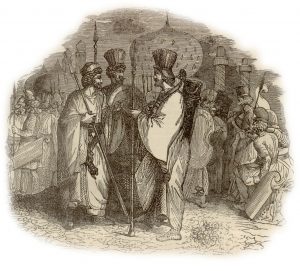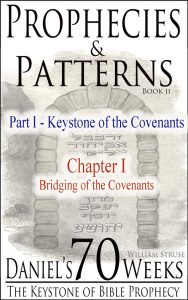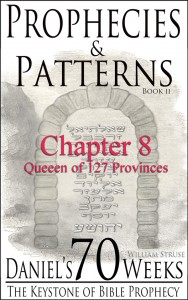 To this day one of the most important, yet least understood aspects of Bible prophecy is the history of Ezra, Nehemiah and their contemporary, the great Persian king “Artaxerxes”. Even less understood is how this history has shaped Continue reading
To this day one of the most important, yet least understood aspects of Bible prophecy is the history of Ezra, Nehemiah and their contemporary, the great Persian king “Artaxerxes”. Even less understood is how this history has shaped Continue reading
Category Archives: Daniel’s 70 Weeks: Keystone of Bible Prophecy
Who is the Artaxerxes in Your Prophecy?
 If there is one bit of Biblical history that reaches across the ages to touch the lives of you and me, (besides the death and resurrection of Yeshua) the reign of the Biblical “Artaxerxes” in the book of Ezra would be at the top of the list. You see, in the 2nd temple era the Bible records that a Persian king “Artaxerxes” gave two different decrees which helped the Jewish people build the temple and the city of Jerusalem. Today the majority of Biblical scholars hold that this king was the Persian Longimanus who ruled from 464-424 BC.
If there is one bit of Biblical history that reaches across the ages to touch the lives of you and me, (besides the death and resurrection of Yeshua) the reign of the Biblical “Artaxerxes” in the book of Ezra would be at the top of the list. You see, in the 2nd temple era the Bible records that a Persian king “Artaxerxes” gave two different decrees which helped the Jewish people build the temple and the city of Jerusalem. Today the majority of Biblical scholars hold that this king was the Persian Longimanus who ruled from 464-424 BC.
The reason this is important to you an me is because it is from the reign of this king that most scholars date the start of Daniel 9 and the 70 Weeks countdown to the Messiah. This date then becomes an important pillar in how we understand the future 7 year tribulation, the rapture, the Antichrist and the second coming of Yeshua. Pretty influential date isn’t it? Continue reading
Darius: Benefactor of the Jewish People
 If I had to name the most unsung secular hero in the Biblical record, hands down it would be Darius the son of Hystaspes also know as Darius ‘the Great’ Artaxerxes.
If I had to name the most unsung secular hero in the Biblical record, hands down it would be Darius the son of Hystaspes also know as Darius ‘the Great’ Artaxerxes.
Practically unknown to most readers of the Old Testament, Darius’ influence on the affairs of the Jewish people during the 2nd temple era is unrivaled. It was during his reign that some of the most important events in the history of the Jewish people took place.
So this week in our search for the the person who gave the “commandment to restore and build Jerusalem” mentioned in Daniel 9:25 we will look at this unsung Biblical hero to see if he qualifies as the one who gave the “commandment” which began our countdown to the Messiah.
“And the God that hath caused his name to dwell there destroy all kings and people, that shall put to their hand to alter and to destroy this house of God which is at Jerusalem. I Darius have made a decree; let it be done with speed.”
Ezra 6:12
It could be argued that Persia’s power and influence reached its zenith during the reign of Darius ‘the Great’ Artaxerxes. Darius played a central role in the Jewish people’s reestablishment of Jerusalem and the temple service. By his sixth year of rule the Second Temple, the very heart of Jerusalem, was completed, nearly sixteen years after permission to build it had first been given by Cyrus.
Darius was the third Persian ruler after Cyrus the Great. (For more on Cyrus see last weeks blog post: Cyrus the “Messiah”) Cyrus died in 530 BC, and his son Cambyses II ruled for eight years. For a short period after Cambyses’s death, Bardis the Magian usurper (aka Smerdis) ruled. This imposter, by some accounts, was a double for Cambyses II’s murdered brother. When Cambyses died, Bardis, who was already impersonating the brother of Cambyses II, took the game to a whole new level and assumed the throne as Artaxerxes of Persia. After ruling for less than a year, he was deposed by Darius ‘the Great’, son of Hystaspes, also known historically as Artaxerxes (Ezra 6:14. See also Ussher, Annals of the World, page 126, section 1015.)
Trouble in the Promised Land
To understand the decree given by Darius ‘the Great’, we need to back up a bit and give a little history of the Jewish people’s efforts to Continue reading
Cyrus the “Messiah”
So who gave the commandment which began the countdown to the Messiah mentioned in Daniel 9:25? In last weeks post A Divine “Command” to Return and Build Jerusalem we asked whether this commandment was of men or God. Scholars have long held that there were four Persian decrees or commandment which might qualify. In this weeks post we will look at the first of four Persian rulers who have been deemed the person who gave the “commandment” of Daniel 9:25.
“That saith of Cyrus, He is my shepherd, and shall perform all my pleasure: even saying to Jerusalem, Thou shalt be built; and to the temple, Thy foundation shall be laid.”
Isaiah 44:28
We begin our search for the “commandment” of Daniel 9:25 with Cyrus the Great of Persia, founder of the Achaemenid Empire. It is believed by some scholars that it was Cyrus’s viceroy or general, Darius the Median, who is mentioned in Daniel 5:31. If you recall, this Darius conquered Babylon on that infamous night when Belshazzar, king of Babylon, asked Daniel to Continue reading
Bridging the Covenants
 The book of Genesis tells us of what is arguably the single greatest tragedy in mankind’s history. It records mankind’s first sin and how, as a result, our ancestors were cursed with death and cast out of Eden. But thankfully, the story doesn’t end there. Mankind is not left without hope of a future restoration and reconciliation with our Creator. Before Adam and Eve were cast out of the garden, our Creator, YHWH, promised them that someday their “seed” would triumph over Continue reading
The book of Genesis tells us of what is arguably the single greatest tragedy in mankind’s history. It records mankind’s first sin and how, as a result, our ancestors were cursed with death and cast out of Eden. But thankfully, the story doesn’t end there. Mankind is not left without hope of a future restoration and reconciliation with our Creator. Before Adam and Eve were cast out of the garden, our Creator, YHWH, promised them that someday their “seed” would triumph over Continue reading
Queen of 127 Provinces
 “Now it came to pass in the days of Ahasuerus, (this is Ahasuerus which reigned, from India even unto Ethiopia, over an hundred and seven and twenty provinces:) . . .” Esther 1:1
“Now it came to pass in the days of Ahasuerus, (this is Ahasuerus which reigned, from India even unto Ethiopia, over an hundred and seven and twenty provinces:) . . .” Esther 1:1
To me one of the coolest statements in the book of Nehemiah is an often overlooked mention of the queen of Persia. It’s a statement that frankly seems out of place unless you understand the chronological context of the Persian era. In the past few chapters, we’ve learned that the Jewish people were shown amazing favor during the reign of Darius ‘the Great’ Artaxerxes. This king over 127 provinces went out of his way to financially support and encourage the construction of the temple of Jerusalem as well as the city itself. It turns out there is more to the story than most of us have realized, and the book of Nehemiah gives us a clue: Continue reading
